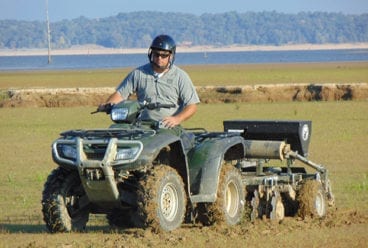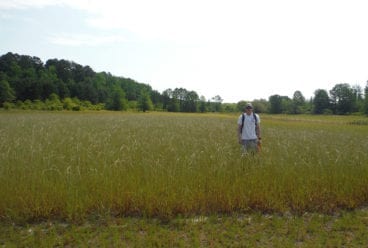Overview
-
Status
Ongoing -
Estimated Completion
2021 -
Location
Enid Reservoir, Mississippi -
Grants Received
$29,225 -
Total Budget
$337,400
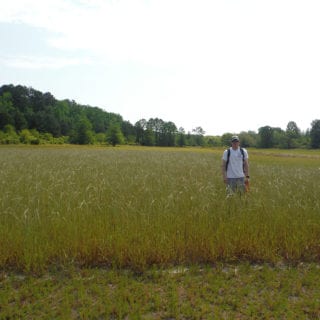
Many reservoirs are characterized by large seasonal or long-term water level fluctuations. These fluctuations generally occur over elevation contours that were once uplands and are now artificially submerged. These uplands have soils, slopes, and seed banks that are different from natural floodplains, and therefore are unable to support the vegetation assemblages that commonly develop in natural floodplains. As a result, the regulated zone of a reservoir (i.e., the contour elevations between conservation and normal pool) are often barren mudflats. Excessive mudflats are a problem in reservoirs nationwide, and have been identified by Mississippi Department of Wildlife Fisheries and Parks (MDWFP) as a major issue limiting fish production in flood control reservoirs in north Mississippi.
To improve fish habitat in mudflats biologists have investigated the effectiveness of seeding barren shorelines with monocultures of annual terrestrial grasses. A limited number of efforts have suggested that seeding exposed shorelines with annual terrestrial grasses can produce lush stands of vegetation that depending on latitude can grow through fall and winter. However, seeding the vegetation often does not persist once inundated, and in some cases it may not last long enough to produce the desired benefits. Moreover, applicability of this management practice has been limited by the difficulties associated with distributing seeds over exposed mudflats.
The objective of this project is to develop Best Management Practices for creating littoral habitat in the face of fluctuating water levels and expected extended drought periods as per climate change predictions. The objective will be accomplished by:
- seeding vegetation in mudflats to promote ground cover, provide structural habitat for fish, improve food availability for fish assemblages, and reduce water turbidity by minimizing wave-induced sediment resuspension; and
- identifying practical seeding management practices applicable to a variety of
“Aging reservoirs in the coastal plains typically have high sedimentation rates leading to extensive shallow mudflats. Couple this with fluctuating water levels and these normal productive areas lack the habitat to sustain bass fisheries. The Enid project is developing another management tool for biologists to provide quality bass fishing under these difficult conditions.”
Why It Matters
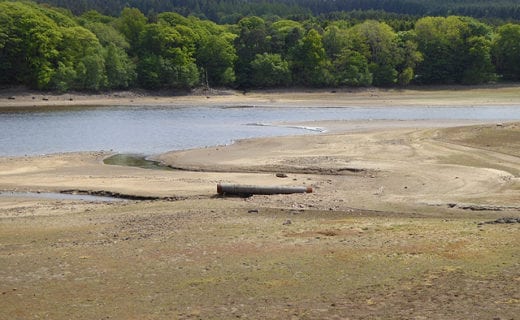
Climate-change predictions for much of the southern and western portion of the U.S. call for increased frequency and duration of drought cycles. Couple this with an ever-increasing society demand for water, fisheries managers can expect more and longer periods of exposure of mudflats. Littoral zones of reservoirs are one of the most productive areas for fish recruitment, growth and survival. Consequently, we can expect reduced production of reservoir fishes with increased exposure of mudflats. Past efforts of planting mudflats and hoping for short-term inundation of these areas have been “hit and miss” at best. Development of Best Management Practices for creating habitat on exposed mudflats is critical to maintaining quality habitat and fisheries in the nation’s large impoundments. This project aims to use a variety of species (16) in various combinations to determine optimal planting protocols for creating quality littoral habitat once these mudflats become inundated.
Threats
Fluctuating water levels make establishment of consistent shoreline cover for juvenile and adult sport fish problematic.
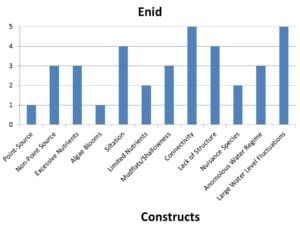 With a median age of 67 years, reservoirs in the USA are showing compelling signs of fish habitat degradation. Habitat losses are often most prominent in littoral zones and are driven by regular and sometimes extreme water level drawdowns mandated by the operational goals of the reservoir. These fluctuations generally limit successful establishment of aquatic and terrestrial plants. Consequently, expansive mudflats form along the regulated zones (elevations between high and low water levels) of reservoirs that are aesthetically displeasing, promote erosion, increase water turbidity when flooded, and cause various ecological problems in aquatic ecosystems.
With a median age of 67 years, reservoirs in the USA are showing compelling signs of fish habitat degradation. Habitat losses are often most prominent in littoral zones and are driven by regular and sometimes extreme water level drawdowns mandated by the operational goals of the reservoir. These fluctuations generally limit successful establishment of aquatic and terrestrial plants. Consequently, expansive mudflats form along the regulated zones (elevations between high and low water levels) of reservoirs that are aesthetically displeasing, promote erosion, increase water turbidity when flooded, and cause various ecological problems in aquatic ecosystems.


